Chinese Journal of Tissue Engineering Research ›› 2013, Vol. 17 ›› Issue (8): 1455-1460.doi: 10.3969/j.issn.2095-4344.2013.08.021
Previous Articles Next Articles
Biological scaffolds for pulp-dentin tissue engineering
Liu Lin, Bao Guang-jie
- Key Laboratory of Stomatology of State Ethnic Affairs Commission, Northwest University for Nationalities, Lanzhou 730030, Gansu Province, China
-
Received:2012-05-17Revised:2012-06-30Online:2013-02-19Published:2013-02-19 -
Contact:Bao Guang-jie, Master, Master’s supervisor, Professor, Key Laboratory of Stomatology of State Ethnic Affairs Commission, Northwest University for Nationalities, Lanzhou 730030, Gansu Province, China helenbgj@sina.com -
About author:Liu Lin★, Studying for master’s degree, Key Laboratory of Stomatology of State Ethnic Affairs Commission, Northwest University for Nationalities, Lanzhou 730030, Gansu Province, China woshiliulin2008@ 163.com
CLC Number:
Cite this article
Liu Lin, Bao Guang-jie. Biological scaffolds for pulp-dentin tissue engineering[J]. Chinese Journal of Tissue Engineering Research, 2013, 17(8): 1455-1460.
share this article
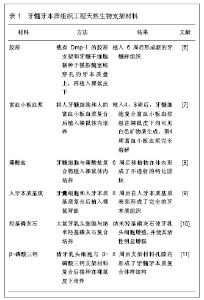
2.1 理想牙本质牙髓组织工程支架材料应具备的条件 理想的牙本质牙髓组织工程支架材料应具备以下条件[5]:①良好的生物相容性。有利于细胞黏附、增殖,无毒,不引起炎症反应。②合适的生物可降解性。降解速度可控,降解产物无毒且容易通过代谢途径排出体外。③足够的力学强度。应足以维持在培养期间结构的完整性以及植入后负荷的支撑和传递。④具有三维多孔结构。多孔结构应该是可控和适当的(即100%的贯通性,平均孔径大于200 μm,足够的表面体积比),以允许细胞附着和生长,组织再生,血管形成及废弃物清除。⑤骨引导作用。应促进血管浸润,细胞浸润和附着及原位成骨。⑥药物释放。应允许附着的活性化合物释放。⑦可消毒。不会造成性能的损失。⑧可塑性。便于加工成所需形状,植入体内一段时间内仍可保持其形状。 2.2 天然生物材料 天然生物材料具有以下优点:成分接近于自然状态下的细胞外基质,生物相容性好;能够提供细胞外基质的化学和结构信息,能调节细胞行为并强化特定外观。但是也存在一些缺点:来源稀少,大量制备困难且质量差异较大;某些种类价格昂贵;降解速度、成孔情况难以人为控制;有传染与动物病原菌或引起免疫应答的风险;可塑性差等。牙髓牙本质组织工程中常用的天然生物支架材料包括胶原、藻酸盐、壳聚糖、羟基磷灰石、磷酸三钙等,见表1。 用胶原、藻酸盐、磷酸三钙、富血小板血浆、人牙本质基质作为支架进行牙体组织再生的体内实验显示,裸鼠体内产生钙化物质或牙本质、牙髓样物质[6-11],且由于富血小板血浆可由自体全血获得,避免免疫排斥反应,激活后富含多种生长因子,作为生物支架材有很大潜力[7]。羟基磷灰石是骨和牙体硬组织的无机成分,具有和牙体硬组织相同的物理、力学和其他特性,但由于羟基磷灰石降解需要的时间长,可能会导致慢性炎症反应[12],因此单独使用羟基磷灰石作为牙髓牙本质组织工程支架材料的报道较少。人牙髓细胞在胶质、藻酸盐和壳聚糖支架上的生长实验表明,藻酸盐和胶质比壳聚糖更适合牙髓细胞的黏附与生长,碱性磷酸酶活性检测提示Ⅰ型胶原、Ⅲ型胶原和藻酸盐能较好促进牙髓干细胞的分化和生长,而壳聚糖完全不能诱导牙髓干细胞的分化[13]。因此胶原可以促进干细胞的分化、黏附和生长,比其他天然生物材料更适合作为牙髓牙本质组织工程支架材料。"
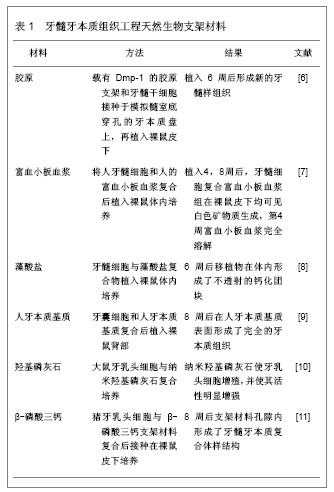
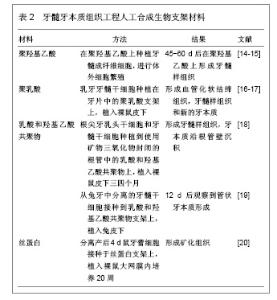
2.3 人工合成材料 人工合成的支架材料有以下优点:可以大规模生产;根据需要进行设计,使其具有符合特定要求的形状;材料内部可设计为多孔结构以方便细胞生长,增殖;降解速度可以调控;能将携带生物源性的病原体或污染物的危险降至最低程度;可将诱导因子等复合于支架材料上以促进细胞进行增殖和分化。牙髓牙本质组织工程中已经得到广泛研究的人工合成支架材料主要包括聚乳酸、聚乙醇酸、乳酸和羟基乙酸共聚物、丝蛋白、自组装多肽等,见表2。 聚乳酸、乳酸和羟基乙酸共聚物、丝蛋白作为支架的体内研究表明动物体内均形成矿化物质或牙髓样组织[16-20]。Young等[23]将接种有猪牙胚组织细胞,并具有牙齿形状的合成聚合物聚乳酸、聚羟基乙酸和乳酸和羟基乙酸共聚物支架植入鼠颌骨中,20周后观察到了具备牙釉质、牙本质组织结构的牙胚的生成。聚乙醇酸作为支架的体外研究显示在45-60 d后在聚羟基乙酸上形成牙髓样组织[14-15]。也有研究显示了聚乳酸、聚羟基乙酸由于其代谢产酸在动物体内存在着引起邻近软组织菌性炎症的问题[24]。另外,合成高分子聚合物支架材料缺乏在天然细胞外基质中发现的化学信息。Galler 等[21-22]将牙髓干细胞种植在自组装多肽支架上进行培养,体外研究结果表明乳牙牙髓干细胞增殖速度较快,有许多软组织样结构形成;牙髓干细胞增殖速度较慢,但向成骨分化,并有矿化组织形成。体内研究结果显示5周后形成牙髓样有血管生成的软结缔组织。"
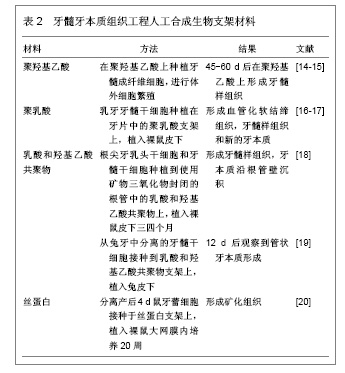
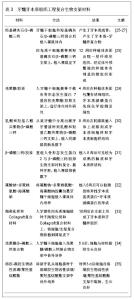
2.4 复合材料 结合了天然生物材料和人工合成材料优点的复合生物支架材料能更好地满足种子细胞生长的需要。已有研究报道的牙髓牙本质组织工程复合生物支架材料见表3。 羟基磷灰石具有很好的生物活性、生物相容性和较高的结合能力,但由于它的力学性能较差、脆较大、且纯羟基磷灰石不易被吸收,限制其使用。与β-磷酸三钙复合后性能改善,应用较为广泛,将牙髓干细胞植入羟基磷灰石/β-磷酸三钙复合支架后进行体内实验,结果表明裸鼠体内产生了牙本质或牙本质-牙髓样复合物及骨[25-27]。壳聚糖机械性能较差,降解产物会使局部pH值降低,可能导致生物体无菌性炎症反应。β-磷酸三钙具有良好的生物相容性和骨引导活性,机械性能好,其不足之处在于缺乏生物活性因子及无法控制其在体内的降解速率。壳聚糖与β-磷酸三钙组合成一种新的三维多孔结构复合材料,使其具有良好的机械强度及韧性,并利用β-磷酸三钙解产物呈碱性这一特性中和壳聚糖所产生的酸性物质,减轻或消除机体炎症反应[34]。"

| [1] Sharpe PT,Young CS. Test-tube teeth. Sci Am. 2005;293(2): 34-41.[2] Malhotra N, Kundabala M, Acharya S. Current strategies and applications of tissue engineering in dentistry--a review Part 2. Dent Update.2009;36(10):639-646.[3] Murray PE,Garcia-Godoy F,Hargreaves KM.Regenerative endodontics: a review of current status and a call for action. J Endod.2007;33(4):377-390.[4] Nakashima M,Akamine A. The application of tissue engineering to regeneration of pulp and dentin in endodontics. J Endod.2005;31(10):711-718.[5] Kadereit S,Udolph G.Umbilical Cord Blood: A Future for Regenerative Medicine.2011,World Scientific Publishing Co. Pte. Ltd. 121 [6] Prescott RS,Alsanea R,Fayad MI,et al. In vivo generation of dental pulp-like tissue by using dental pulp stem cells, a collagen scaffold, and dentin matrix protein 1 after subcutaneous transplantation in mice.J Endod.2008;34(4): 421-426.[7] 刘中宁,姜婷,王衣祥.富血小板血浆促进人牙髓细胞的体内矿化潜能[J].北京大学学报:医学版,2011,43(2):276-279.[8] Fujiwara S,Kumabe S,Iwai Y.Isolated rat dental pulp cell culture and transplantation with an alginate scaffold. Okajimas Folia Anat Jpn.2006;83(1):15-24.[9] Li R,Guo W,Yang B,et al. Human treated dentin matrix as a natural scaffold for complete human dentin tissue regeneration.Biomaterials.2011;32(20):4525-4538[10] 方厂云,曹莹,夏宇,等.大鼠牙乳头细胞与纳米羟基磷灰石的体外复合培养[J].中南大学学报:医学版,2007,32(1):114:118.[11] 张富强,傅远飞,吴伟,等.猪牙乳头细胞与β-磷酸三钙支架构建牙髓牙本质复合体样结构[J].中国组织工程研究与临床康复, 2008,12(6):1009-1012.[12] Götz W,Lenz S,Reichert C,et al. A preliminary study in osteoinduction by a nano-crystalline hydroxyapatite in the mini pig. Folia Histochem Cytobiol.2010; 48(4):589-596.[13] Kim NR,Lee DH,Chung PH,et al. Distinct differentiation properties of human dental pulp cells on collagen, gelatin, and chitosan scaffolds. Oral Surg Oral Med Oral Pathol Oral Radiol Endod. 2009;108(5):e94-100.[14] Mooney DJ,Powell C,Piana J,et al. Engineering dental pulp-like tissue in vitro. Biotechnol Prog.1996;12(6):865-868.[15] Bohl KS, Shon J,Rutherford B,et al. Role of synthetic extracellular matrix in development of engineered dental pulp. J Biomater Sci Polym Ed.1998;9(7):749-764.[16] Cordeiro MM,Dong Z,Kaneko T,et al. Dental pulp tissue engineering with stem cells from exfoliated deciduous teeth. J Endod.2008;34(8):962-969.[17] Sakai VT,Zhang Z,Dong Z,et al.SHED differentiate into functional odontoblasts and endothelium.J Dent Res.2010; 89(8):791-796.[18] Huang GT,Yamaza T,Shea LD,et al.Stem/progenitor cell-mediated de novo regeneration of dental pulp with newly deposited continuous layer of dentin in an in vivo model. Tissue Eng Part A.2010;16(2):605-615.[19] El-Backly RM,Massoud AG,El-Badry AM,et al.Regeneration of dentine/pulp-like tissue using a dental pulp stem cell/poly(lactic-co-glycolic) acid scaffold construct in. New Zealand white rabbits.. Aust Endod J.2008;34(2): 52-67.[20] Xu WP,Zhang W,Asrican R,et al. Accurately shaped tooth bud cell-derived mineralized tissue formation on silk scaffolds.Tissue Eng Part A.2008; 14(4):549-557.[21] Galler KM,Cavender A,Yuwono V,et al. Self-assembling peptide amphiphile nanofibers as a scaffold for dental stem cells.Tissue Eng Part A.2008; 14(12):2051-2058.[22] Galler KM,Hartgerink JD,Cavender AC,et al. A customized self-assembling peptide hydrogel for dental pulp tissue engineering. Tissue Eng Part A. 2012; 18(1-2):176-184.[23] Young CS,Terada S,Vacanti JP,et al.Tissue Engineering of Complex Tooth Structures on Biodegradable Polymer Scaffolds. J DENT RES. 2002;81(10):695-700.[24] Luo X,Zhou G,Liu W,et al.In vitro precultivation alleviates post-implantation inflammation and enhances development of tissue-engineered tubular cartilage. Biomed Mater.2009;4(2): 025006.[25] Gronthos S,Mankani M,Brahim J, et al. Postnatal human dental pulp stem cells (DPSCs) in vitro and in vivo. Proc Natl Acad Sci USA. 2003;97(25):13625-13630.[26] Miura M,Gronthos S,Zhao M,et al.SHED: stem cells from human exfoliated deciduous teeth. Proc Natl Acad Sci USA. 2003;100(10):5807-5812.[27] Gronthos S,Brahim J, Li W,et al. Stem cell properties of human dental pulp stem cells. J Dent Res.2002;81(8): 531-535.[28] Yang X,Walboomers XF,van den Beucken JJ,et al. Hard tissue formation of STRO-1-selected rat dental pulp stem cells in vivo. Tissue Eng Part A. 2009;15(2):367-375.[29] Yang X,Han G,Pang X,et al.Chitosan/collagen scaffold containing bone morphogenetic protein-7 DNA supports dental pulp stem cell differentiation in vitro and in vivo. Biomed Mater Res A.2012, in press.[30] Zheng L,Yang F,Shen H,et al. The effect of composition of calcium phosphate composite scaffolds on the formation of tooth tissue from human dental pulp stem cells. Biomaterials. 2011;32(29):7053-7059.[31] 张文涛,刘建华,王慧明,等.重组人BMP-2修饰的β磷酸三钙/ 胶原材料制备及其诱导成牙性能的初步研究[J].中国修复重建外科杂志,2011,25(2):149-154.[32] 王瑛慧,王万永,贾智. APA微囊包裹的牙髓干细胞成牙本质作用的研究[J].天津医科大学学报,2006,12(4):548-550.[33] 包柳郁,金岩,史俊南,等.人牙源性间充质细胞体内立体培养模型的建立--构建组织工程化牙本质和牙髓组织[J].牙体牙髓牙周病学杂志,2004,14(11): 603-606.[34] 李珊,樊明文,梁素霞. 成人牙髓干细胞与壳聚糖-磷酸三钙复合材料相容性试验研究[J].口腔医学研究,2006,22(3):264-266.[35] 陈建洪,唐倩,王萍,等.应用SGBG/PHBV复合材料构建牙本质牙髓复合体样结构的初步研究[J].临床医学工程,2011,18(9): 1339-1340.[36] Tonomura A,Mizuno D,Hisada A,et al. Differential effect of scaffold shape on dentin regeneration.Ann Biomed Eng.2010; 38(4):1664-1671.[37] 彭伟伟,翟万银,江龙,等.人牙髓细胞复合不同孔径羟基磷灰石/磷酸三钙支架材料的生物学行为[J].中国组织工程研究与临床康复,2010,14(51):9567-9571.[38] Dong H, Paramonov SE, Aulisa L, et al. Self-assembly of multidomain peptides: balancing molecular frustration controls conformation and nanostructure. J Am Chem Soc. 2007;129(41):12468-12472.[39] Brennan EP,Reing J,Chew D, et al. Antibacterial activity within degradation products of biological scaffolds composed of extracellular matrix . Tissue Eng. 2006;12(10):2949-2955.[40] Salick DA, Kretsinger JK, Pochan DJ, et al. Inherent antibacterial activity of a peptide-based beta-hairpin hydrogel.J Am Chem Soc.2007;129(47):14793-14799. |
| [1] | Zhang Tongtong, Wang Zhonghua, Wen Jie, Song Yuxin, Liu Lin. Application of three-dimensional printing model in surgical resection and reconstruction of cervical tumor [J]. Chinese Journal of Tissue Engineering Research, 2021, 25(9): 1335-1339. |
| [2] | Shen Jinbo, Zhang Lin. Micro-injury of the Achilles tendon caused by acute exhaustive exercise in rats: ultrastructural changes and mechanism [J]. Chinese Journal of Tissue Engineering Research, 2021, 25(8): 1190-1195. |
| [3] | Zeng Yanhua, Hao Yanlei. In vitro culture and purification of Schwann cells: a systematic review [J]. Chinese Journal of Tissue Engineering Research, 2021, 25(7): 1135-1141. |
| [4] | Liang Xueqi, Guo Lijiao, Chen Hejie, Wu Jie, Sun Yaqi, Xing Zhikun, Zou Hailiang, Chen Xueling, Wu Xiangwei. Alveolar echinococcosis protoscolices inhibits the differentiation of bone marrow mesenchymal stem cells into fibroblasts [J]. Chinese Journal of Tissue Engineering Research, 2021, 25(7): 996-1001. |
| [5] | Duan Liyun, Cao Xiaocang. Human placenta mesenchymal stem cells-derived extracellular vesicles regulate collagen deposition in intestinal mucosa of mice with colitis [J]. Chinese Journal of Tissue Engineering Research, 2021, 25(7): 1026-1031. |
| [6] | Xu Dongzi, Zhang Ting, Ouyang Zhaolian. The global competitive situation of cardiac tissue engineering based on patent analysis [J]. Chinese Journal of Tissue Engineering Research, 2021, 25(5): 807-812. |
| [7] | Li Wenjing, Li Haobo, Liu Congna, Cheng Dongmei, Chen Huizhen, Zhang Zhiyong. Comparison of different bioactive scaffolds in the treatment of regenerative pulp of young permanent teeth [J]. Chinese Journal of Tissue Engineering Research, 2021, 25(4): 499-503. |
| [8] | Wu Zijian, Hu Zhaoduan, Xie Youqiong, Wang Feng, Li Jia, Li Bocun, Cai Guowei, Peng Rui. Three-dimensional printing technology and bone tissue engineering research: literature metrology and visual analysis of research hotspots [J]. Chinese Journal of Tissue Engineering Research, 2021, 25(4): 564-569. |
| [9] | Li Li, Ma Li. Immobilization of lactase on magnetic chitosan microspheres and its effect on enzymatic properties [J]. Chinese Journal of Tissue Engineering Research, 2021, 25(4): 576-581. |
| [10] | Chang Wenliao, Zhao Jie, Sun Xiaoliang, Wang Kun, Wu Guofeng, Zhou Jian, Li Shuxiang, Sun Han. Material selection, theoretical design and biomimetic function of artificial periosteum [J]. Chinese Journal of Tissue Engineering Research, 2021, 25(4): 600-606. |
| [11] | Liu Liu, Zhou Qingzhu, Gong Zhuo, Liu Boyan, Yang Bin, Zhao Xian. Characteristics and manufacturing techniques of collagen/inorganic materials for constructing tissue-engineered bone [J]. Chinese Journal of Tissue Engineering Research, 2021, 25(4): 607-613. |
| [12] | Liu Fei, Cui Yutao, Liu He. Advantages and problems of local antibiotic delivery system in the treatment of osteomyelitis [J]. Chinese Journal of Tissue Engineering Research, 2021, 25(4): 614-620. |
| [13] | Li Xiaozhuang, Duan Hao, Wang Weizhou, Tang Zhihong, Wang Yanghao, He Fei. Application of bone tissue engineering materials in the treatment of bone defect diseases in vivo [J]. Chinese Journal of Tissue Engineering Research, 2021, 25(4): 626-631. |
| [14] | Zhang Zhenkun, Li Zhe, Li Ya, Wang Yingying, Wang Yaping, Zhou Xinkui, Ma Shanshan, Guan Fangxia. Application of alginate based hydrogels/dressings in wound healing: sustained, dynamic and sequential release [J]. Chinese Journal of Tissue Engineering Research, 2021, 25(4): 638-643. |
| [15] | Chen Jiana, Qiu Yanling, Nie Minhai, Liu Xuqian. Tissue engineering scaffolds in repairing oral and maxillofacial soft tissue defects [J]. Chinese Journal of Tissue Engineering Research, 2021, 25(4): 644-650. |
| Viewed | ||||||
|
Full text |
|
|||||
|
Abstract |
|
|||||

